This is a complete guide to our Everest base camp trek packing list. We have updated it with the items that we should have brought with us and must have items on your packing list for the EBC Trek.
So you have finaly decided to fulfill the ultimate bucket list item of trekking to Everest Base Camp. But how do you pack for such a trip? Don’t worry, we’ve done it and have since done many other treks in the Himalayas and through mountains aroudn the world. We have perfected (well, as much as we can) our packing list and created the ultimate packing guide for your Everest Base Camp Trek.
Table of Contents
Everest Base Camp Packing List
It is a little daunting planning a trek to Everest. But the most daunting task together a packing list for our Everest Base Camp Trek. While in Kathmandu, we packed and unpacked our bag several times before feeling good about our gear.
You want to pack light but you want to make sure you have enough gear to survive the colder temperatures and the 14 days of trekking above 4000 meters. (13,123 feet).
We got our gear down to one backpack between us and two day packs that we carried oursleves. That included camera gear.
Here is a list of the gear that we packed for Everest.
Quick Tips – Packing Gear for Everest Base Camp
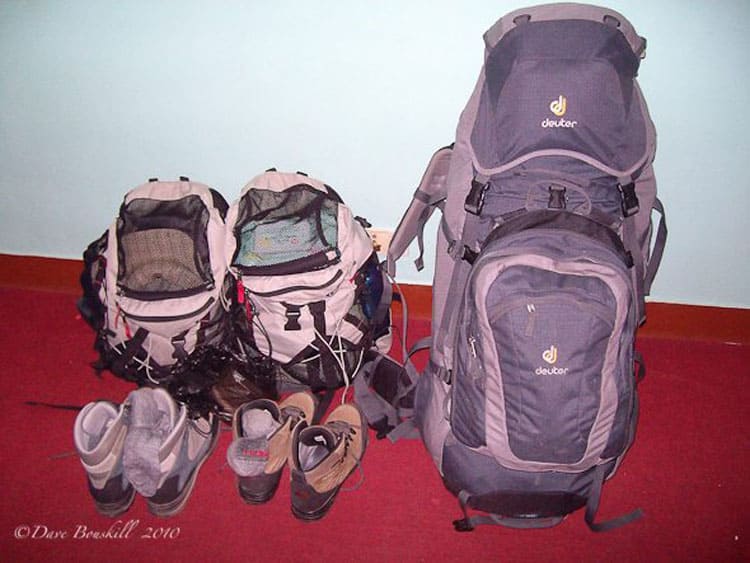
This list is for 1 person, we each brought the same amount of travel gear, but to keep things simple, we are including only what 1 person needs to pack for Everest Base Camp.
It is important to pack layers for your Everest Base Camp trek.
Wear lightweight clothing that is breathable
Dress in layers so you can peel them off when you get hot, and add them as it gets cold. Three layers is perfect for trekking:
- Base Layer – Merino Wool top and bottoms. It is lightweight, breathes, and doesn’t smell making it perfect for wicking away moisture.
- Mid Layer – We wore fleece as our base layer on Everest. Fleece pants and a zip-up fleece jacket. When we got to colder and higher elevations, we worked a lightweight down jacket which.
- On other treks in the Himalayas, we have since switched to a thicker merino wool jacket. It is more breathable. And have stuck with our lightweight Canada Goose Hybridge down jacket.
- Outer layer – Choose something that is waterproof and breathable Nylon or polyester material. We use GoreTex and have for years. it is durable, waterproof, windproof and breathable. That is very much the key. If you get an outerlayer that isn’t breathable, you will sweat and it will hold in the moister. Getting wet and cold is dangerous.
- Read our complete 5 Winter Layering Tips to Dress for the Deep Freeze
Weather can change rapidly. One minute you can be working up a sweat as you climb uphill and then as the temperature drops, you will be freezing in the cold.
Make sure to have tested all of your gear before trekking to Base Camp. Don’t wear new boots on the trek, make sure that they are worked in. Do several hikes at home before trekking to Everest. Boots should be worn in and comfortable.
Also, check all batteries in headlamps and cameras before your flight to Lukla. Charging stations are limited on the Everest base camp trek, so be sure to have every charged up and bring plenty of spares.
Trekking clothes for Everest
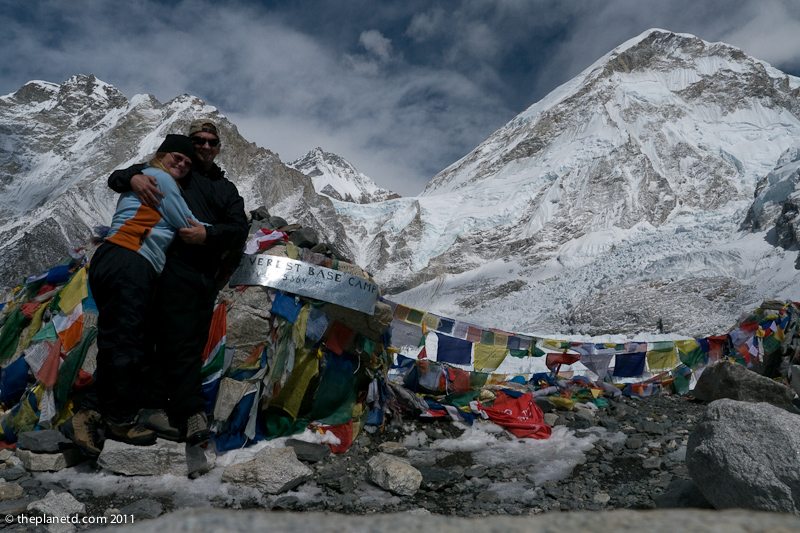
- 2 quick drying long sleeved base layer shirts – Light weight and quick dry is key. We brought 2 to be able to alter them daily.
- 2 trekking shirts short sleeve – Even though it is chilly, you will get hot. Short sleeved shirts are good to wear at lower altitudes.
- 2 Thermal underwear – A good merino wool base layer is a must. We suggest packing 2 pairs of thermal underwear so that you can air out one each night. Or change into dry thermal underwear at the tea houses to sleep in after your trek while letting your other base layer dry.
- 2 liner socks – Liner socks are good to wear under trekking socks to which away moisture and prevent blisters.
- 3 pair woolen blend trekking socks – You could pack four pairs, but three is enough. 2 is not enough as you’ll need to dry socks at the end of the day and have another to wear while lounging at the
- 2 pair trekking pants – When trekking we prefer zip-off bottoms. I tend to run hot when trekking and I always zip off my pants in mid day but like the option of zipping them back on when stopping.
- 2 fleece sweaters – Midlayer – one lightweight, one heavier. It gets cold over 5000 meters, so you’ll want a warmer mid layer.
- Underwear – We like clean underwear and don’t like washing in the middle of a trek every night. We packed 7 pairs each. Really, underwear doesn’t take up much space. But if you like to wash, go ahead and pack lighter.
Outer Layers for EBC Trek
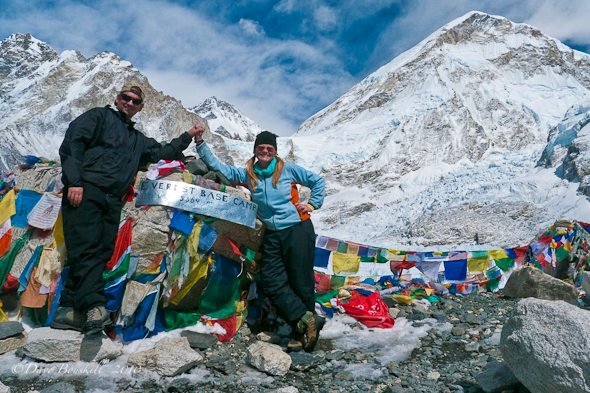
- 1 wind/rain proof overlayer– jacket and pants
- 1 down jacket – didn’t really need this, layers would have been fine, but it does get quite cold in March. We are fans of the Canada goose Hybridge down jacks. Plus, a down jacket was great to sleep in.
- 1 down vest – I bought this in Kathmandu and loved having it to lounge around the tea houses. Down is very lightweight, so it doesn’t take up a lot of space.
- 1 Warm winter hat – We bought sherpa hats in Namche Bazaar and they worked like a charm.
- 1 lightweight thermal layer hat – Weather varies on the mountain. I liked having a hat to keep my ears warm, but a light one was sufficient at lower altitudes.
- 1 peak hat – The sun is strong above the clouds, a peak hat is a must.
- 1 headband/buff – I love hiking in a buff. I put it around my neck when I’m cold and put it on my head to keep sweat out from running in my face when its hot.
- 1 pair gloves – It is cold (especially in March) above 4000 meters. Your fingers will thank you.
- 1 Pair trekking/hiking boots – Be sure to have used your boots beofre your trek. Don’t buy brand new boots. They should be worked in and well worn. That way you won’t get surprise blisters. We are fans of Merrell Hiking boots.
- 1 Pair crocks or Birkenstocks – I recommend sandals that you can wear with socks instead of flipflops. I
- 1 pair down booties – We bought these at Namche Bazar and they saved our feet.) Great for keeping feet warm in the room (as teahouse rooms are not heated) and while sleeping and for in the lodge.
Trekking Gear for Everest Base Camp
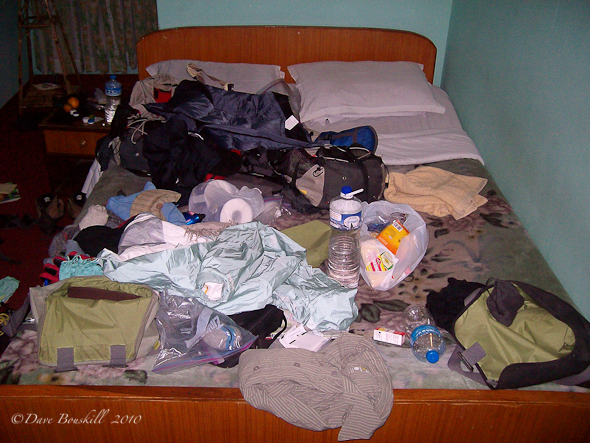
Since you are staying in Tea houses when climbing to Everest Base Camp, you don’t need a lot of extra travel gear. If you find you need more, you can pick up what you forgot at Namche Bazaar.
- 1 headlamp – Teahouses don’t have electricity in halls and rooms, a handsfree headlamp is a good option over a phone light.
- 1 sleeping bag heavy – (could have gone more lightweight as tea houses supply blankets as well. )
- 1 watch with alarm – Your cell phone will get cold at night, a good old fashioned digital watch is great for early morning wake up.
- 2 Pairs of sunglasses (in case one breaks) – Believe me, I had a pair of sunglasses break while climbing Mount Kilimanjaro and I regret not having extra sunglasses. Pack two because you don’t want to injure your eyes.
Gear for Everest Base Camp
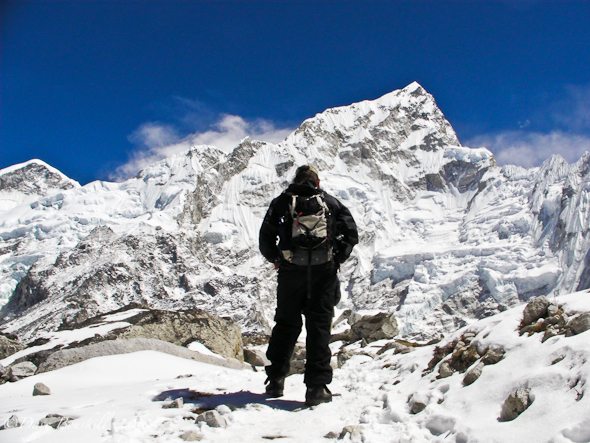
You don’t want to go overboard on carrying electronics when climbing to base camp. Every extra piece of gear will feel extremely heavy.
On the other hand, it’s a once in a lifetime chance and you will want to capture as many photos as possible.
- To see our full camera gear list, see the Complete Photography Gear Guide
- 1 DSLR camera with 3 extra batteries (charging is expensive on the mountain, but you can charge your batteries if they go dead for a fee). You also want 3 batteries because they go dead faster in the cold.
- 1 Point and shoot camera or cell phone camera – Yes, you’ll want to use your professional camera for those amazing views, but you’ll also want to be able to grab quick snaps.
- GoPro – We never travel without our GoPro, especially on adventures.
- 1 solar charger (charging is expensive if you can charge yourself will save money)
- 2-3 portable power banks – Power banks are perfect for charging your electronics. If you pack these, you won’t have to worry about paying for charging.
- Belkin mini surge protector and adapter – If you do need to charge from an outlet, this will protect your electronics from a power surge. And you can plug a lot of items into it so you won’t have to flight for an outlet with other trekkers.
- extra batteries for headlamps
Hot Tip: Keep batteries close to your body, that will make them last longer.
Teahouse Clothing
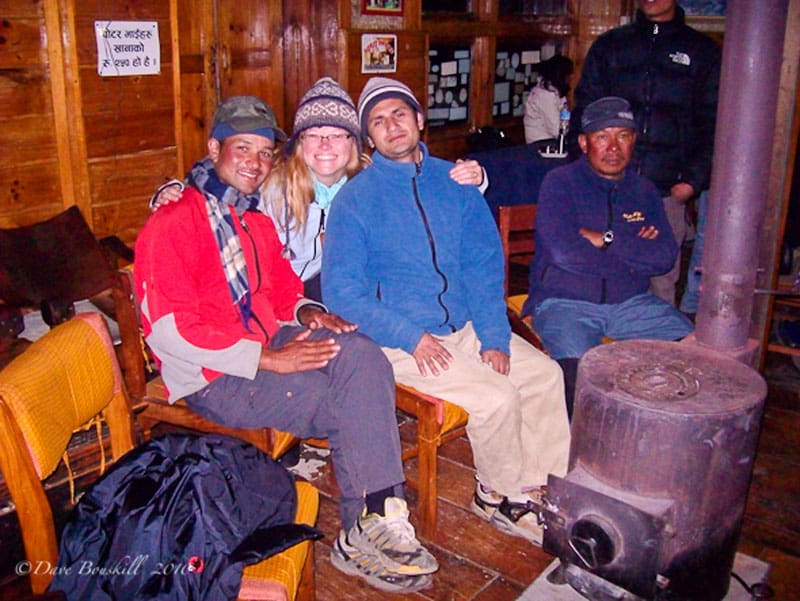
We found that we didn’t change too much from our trekking gear in the tea houses. But there were a couple of extra items we packed. You don’t need to dress up in the teahouses. It is a rugged trek after all, so you can relax and dress casual.
- I liked wearing my base layer with a merino wool skirt overtop. Dave changed into light trekking pants.
- We both wore short sleeved shirts under zipped fleece sweaters so we could peel layers off as the woodstove burned.
- Crocks with thick wool socks did the trick for us. We could slip them on and off and our feet got a break from our boots.
- When you get to higher elevations, it is colder walking from your room to the main restaurant. So, you may want to wear your base layer with trekking pants overhead.
- I don’t think I ever took my hat off on this trek.
- we don’t recommend jeans at anytime as they are heavier in weight (so why put your porter through more weight) and they aren’t quick dry. Stick with lightweight breathable materials.
Snacks and Extras

- Tang – or any other powdered juice. We bought this in Kathmandu and it helped us stay hydrated. I felt naseous sometimes due to altitude and the flavoured water made the fluid go down better. Plus it helped to replenish our electrolytes.
- Tea – you can boil water in teahouses for free.
- dairy milk bars – chocolate is a must. It is expensive on the trek, so stock up in Kathmandu.
- trail mix and peanuts – I found that I couldn’t stomach a lot of food on certain days, and trail mix and peanuts gave me the salt I needed.
- Journal – Everest is a good time to go inward and reflect. Keeping a journal will create amazing memories.
- paperback book – Skip electronics, use paper so you don’t have to worry about batteries. Check out our list 24 Best Travel Books to Inspire the Wanderer in You
First Aid for Trekking EBC
- Diamox – for altitude
- Ibuprofen (Tylenol) – for headaches
- Naproxen (Aleve) – for aches and pains
- Vicks vapor rub – I was quite congested on the mountain and slathered myself with Vicks each night.
- Sunscreen – The sun is very strong at altitude.
- Chapstick – It is very dry at altitude and your lips will most likely crack if you don’t have chapstick.
- anti nauseant – you tend to feel just a little bit nauseaus at altitude. At least I do. I find taking an anti nauseant keeps it at bay.
- Immodium – diarrhea is common at altitude especially over 5000 meters.
- blister bandaids or moleskin – Moleskin is great for blisters in boots as it doesn’t come off. Have a few bandaids on hand as well.
- eye drops – My eyes were very dry on the trek
- Advil cold and sinus or Dayquil – My sinuses became very congested and this helped me to sleep at night.
- nasal moisturizer – altitude causes nasal cavities to be very dry, nasal moisturizer was very helpful
- Q-tips
- tweezers
- tiger balm – A good rub to help with aches.
Read our complete first aid kit for travelers
Toiletries
- foot powder – great to put in boots at the end of the day.
- Toilet paper – pack your own toilet paper
- shampoo – put it in a small bottle or GoToob
- soap – For that one or two hot showers you manage to have.
- microfiber towel – for obvious reasons. A microfiber towel is lightweight
- Gold Bond – this just feels good all the time and we like this medicated bond way better than baby powder.
- nail clippers – Good to keep toenails trimmed when trekking
- The usual toiletries – toothbrush, toothpaste, different
- Hand Sanitizer –
- Baby Wipes or Wet Ones – A life Saver when you haven’t showered for days.
See what the flight from Kathmandu to Lukla was like
Documents
- Passports – You will have to show them at check points.
- TIMs Card (permit to allow you into park bought in Kathmandu)
- Plenty of Rupees – There are no ATM’s along the trail
- Map and Lonely Planet – There is a lot to read about on the trek and a lot to see. The Lonely Planet helps you know what to look for.
- Extra Passport Photos – we had to leave photos with check-in
Accessories
Ear Plugs – When staying at teahouses, there are other groups there and it can get loud.
Noise Cancelling Headphones – You may want to listen to music or watch a movie on your iPhone.
So there you have it, that’s our packing list for Everest Base Camp.
Note: We have since gone over this packing list and found that it all worked very well for Everest Base Camp Trekking.
We didn’t feel that we over packed at all and we felt that we had enough travel gear to make it through everything we needed.
Plus, we felt that we didn’t overload our porter Sher, he only had to carry one backpack between the two of us.
Going to Everest Base Camp? Read our Insider tips for trekking to EBC
See more packing and gear guides
- The Ultimate Travel Packing List (By Professional Travellers)
- 5 Winter Layering Tips to Dress for the Deep Freeze
- The Best Travel Gear – Unique Ideas for Smart Packing
- Travel Tips for Winter Packing
Read More About Nepal Travel
- Everest Base Camp Trek – Ultimate Guide to Hiking Everest in Nepal
- Remarkable Everest Base Camp Trek in Photos
- Flight to Lukla – A Scary Thrill Ride to Everest
- 30 Tips for Trekking to Everest Base Camp
- Top 6 Places to visit in Kathmandu, Nepal
- Where to Eat in Kathmandu – Eight Great Spots to Indulge After Your Trek
- How I Entered Nepal from India On a Budget
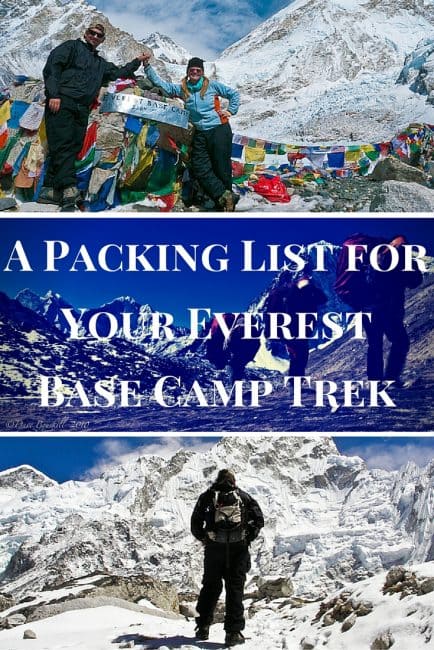

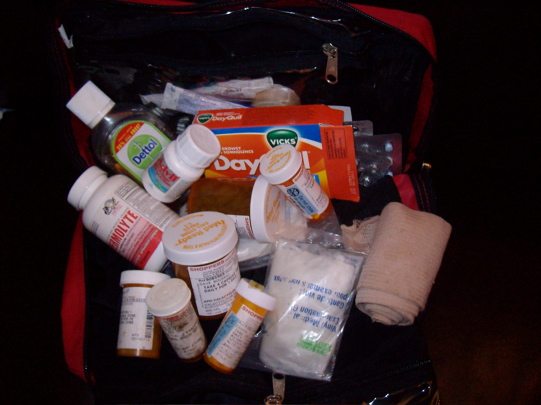
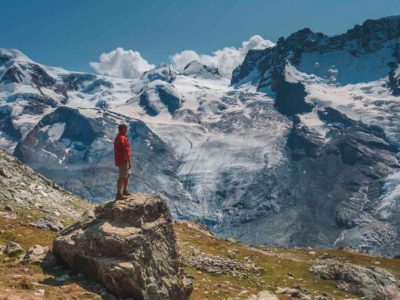
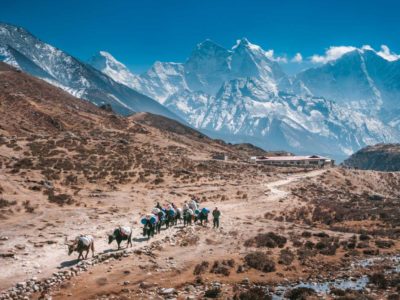
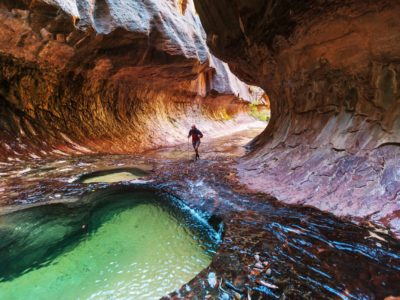
Hi, Great Article! Thank You for Sharing Such a wonderful Guides with Us Please Keep Sharing. I will Definitely Follow All Above Mentioned Tips. Please Keep Sharing
Hello,
I am going to Nepal in 10 days and I would like to ask whether I can buy all the medicine you mentioned there or is it better to buy it at home because it is safer?
We bought all our medicine in Kathmandu. But to be safe, we recommend having it on hand from home as well. We were traveling for quite some time when we arrived in Nepal and had to re-stock. But we always leave home with what we need. Rules can change and stocks can change, so we advise going to a travel clinic to talk to them about what you need before you go.
curious on what to expect on trek in December; leave 12/3/18 and hoping to steer clear of major weather changes; does layering or gear list change?
I would contact our guide Dipendra, he would have a better idea of conditions on the mountain.
http://www.simriknepaltreks.com/contact/
Cheers
Deb
Hi! Going to EBC in April and was wondering how many liters was your day pack. I am considering carrying just a 24lts day pack. In high altitude, how much do you carry in your pack?
Hi Paola, our day pack was bigger. Dave’s camera bag is 40 litres, so you’ll be great with 24. We hired a porter and a guide and our porter carried our backpacks with hiking gear and clothes. He always beat us to camp so when we got there we could change into warm dry clothes and socks. I think our backpacks were lighter than our day packs because we carried camera gear with us. haha. You don’t need a lot of change of clothes for Everest Base Camp, but you do want layers and a couple of changes in case you are wet (I tend to sweat a lot) and want to put on warm clothes once you reach your guest house. Have fun and let me know how it goes!
I am doing EBC in March and appreciate this post very much!!
I am wondering – did you use water purification tablets? or was boiled water available??
We used water purification tablets then, but I recommend a SteriPen now. You can buy it at any outdoors store or on Amazon. (Here’s an affiliate link to Amazon http://amzn.to/2pd01n2 – Steripens are a great way to purify water and it doesn’t have the medicine taste like purification tablets. But they do need batteries, and betteries can really run out fast on Everest, so I would still recommend tablets as a back up. And remember to keep batteries close to your body when not using them. We take them out of our equipment and in an inside pocket when trekking.
Such a brief information you have provide in here. Can you also explain the cost per day including the cost of the hotels and food.
Hi!
Thanks for your list!
Could you tell what kind of boots did you use? How much waterproof they have to be? Is it really snowy on the trail? We did Annapurna and there was just a shallow level of snow and we were wearing low hiking sneakers with ventilation net in some places. And it was ok, feet were still dry. Is track to EBC pretty different?
Hope to hear from you!
We use Merrel for Dave and Keen for Deb hiking boots. Both are completely waterproof and breathable. Here’s a link to our packing list that we bring with us all the time. https://theplanetd.com/travel-packing-list/
Hi Guys,
How did you do with your clothes? Did you wash them while in the mountain?
We didn’t wash them at all. You just end up smelling a lot. Ha! We both packed enough underwear, lightweight and breathable so itdidn’t take up much space. Other than that we just brought 3 sets of base layers and three (maybe 4) pairs of socks. That way we had something dry and semi clean to change into after trekking while letting our trekking clothes air out. The third layer was for later in the trip and for any emergencies should a base layer get really wet or wrecked. For this trip, we didnt’ worry too much about washing. But I remember there were shops/tea houses that offered laundry services. Just be prepared to hang around an extra day as there aren’t clothes dryers. Have a great trip!
Hi! Just stumbled upon this. I climbed kilimanjaro as well and now looking into the everest climb. Would you be able to tell me what some of the differences are between the treks? Why is it about 2 weeks to climb instead of 6? Do we have to tip the porter/guide like we did on kilimanjaro? This kind of info would be fantastic! I’m female going solo again!
Hi Sasha, thanks for the message. Yes, you should tip your porter and guide. It is a 10-11 day climb because it covers a lot more distance. It is also a sustained climb over 4000 meters for the entire trip. Kilimanjaro is only twos over 4000 metres and then you come down the same day you summit. Once you reach Everest Base Camp, you stay up there that night at Gorep Shep. You then start to come back down.
Wow, your site & advice are amazing! I was wondering your opinion of trekking poles: are they needed? If so, would u recommend 1 or 2? Thanks! 🙂
Is there any more permit required to enter the Sagarmatha national park except the TIMS permit…
Thanx
Hi
Thanks for your list! It is very thorough and things I did not think of. I am heading up to do everest base camp mid november….just me and a guide. Never done anything like this before … so all the information was helpful.
cheers Tracy (sydney – Australia)
Great and comprehensive list! Thanks for sharing it with the world. 🙂
We had a question about “expensive” charging. Do you pay per outlet used, or is there some other way they measure how much electricity you consume?
Thanks!
Good question, they pay a flate rate per hour and per outlet. It can really add up for sure.
Thanks DebnDave for the super super Journal.
I am heading to the EBC in another 4 weeks and this surely helped calm some nerves. Hope I am in good enough shape to go the distance and enjoy the journey too !!
Cheers!!
Hi Rahul, you’ll be fine. The great thing about trekking to Everest is you can take it as slow or as fast as you wish. Give yourself enough time to rest and get used to the altitude and you will have a very good chance of getting there and feeling great in the process. Make sure to drink plenty of water. Cheers.
great info..im heading to everest base camp on nov 9.ur list helped me so much.my ques is can i buy those things there?thanx again 4 ur info
Leaving tomorrow for Nepal to make an expedition to summit Mera Peak (6,476 m). Your packing list was great. If you look at our latest blog, you can see our own Nepal gear list. Keep in mind we’re doing a summit, so we had to have climbing gear.
http://maximumadventure.files.wordpress.com/2011/09/mera-peak-checklist1.png
Hi Chris, have a great time. Yes, I am sure that you have a way better packing list than us doing an expedition. Ours was pieced together from shopping in Kathmandu. We had been traveling around India and Sri Lanka for quite a few months before going to Nepal, so we had to pretty much start from scratch there. Have a super climb and we look forward to following along!
Interesting. I did this trek end of December 2010. Backpacking was very difficult. I had a backpack of 19 kg and I just wonder how could I get easier in the future.
I have read only one post of it, as I have a lot of exams now and I just returned from Himalaya, but I will read you starting February 🙂
Anka
I’ve become a recent daily reader of your blog. My boyfriend and I are heading to India and Nepal for a few months in September and therefore I find your posts even more helpful! I didn’t even think about doing the Base Camp Trek before, but your posts have inspired both of us too get in shape and head out for one crazy/beautiful adventure. Thanks for all the advice, sounds like we’re going to need it!
.-= Nicky´s last blog ..Bigger, Brighter World (Amaris Lasik) =-.
Nicky thank you so much for the kind words. You can totally do the Base Camp Trek. Just take your time and drink plenty of water and take diamox. They sell it for really cheap in Kathmandu so don’t bother spending the money and a doctors visit in North America. I can’t wait to hear how your trip goes in both India and Nepal!
My dear Friends, Dave & Bed, I am reall impressived about the website. I feeled that I was so great to be your Guide for Everest Adventure trekking. Hope you will also help me to bring my future in the light path from the dark.
I’ve been dreaming of doing this, thanks for sharing 🙂
BTW, how much did the package cost you?
.-= flip´s last blog ..How Cheap is Cheap Backpacking? =-.
Well of course I agree with everyone! I am looking forward to reading the followup to find out how you’d adjust your packing list based on experience, and I can’t wait to see what is sure to be more stunning photos!
Enjoy it and be safe!
.-= Trisha Miller´s last blog ..If You’re Going Up The Creek, Take a Paddle =-.
Wow, good luck with your climb. Can’t wait to read how it went.
.-= Maria Staal´s last blog ..The University Library Challenge =-.
I’m so excited for you guys! Can’t wait to see amazing pictures from Dave and story from Deb.
.-= Amy @ The Q Family´s last blog ..Best 5 Fun Things to Do with Kids in Columbia, SC =-.
I am so excited for y’all. This is something we have very much talked about doing and can’t wait to hear how it goes.
.-= Akila´s last blog ..the currency of kindness =-.
I’m with Laura–would love to see which of this gear you don’t end up using. Best of luck on your trek! Try to make it to Kala Patar or Gokyo Ri if you can…much better views of the Himalaya than Everest Base Camp. Much less touristy as well.
STOKED for pictures 🙂
.-= Alan´s last blog ..Abroad Care, Stage 1: Forming an LLC =-.
(another Laura haha!) I am so jealous! You guys must be so excited. Can’t wait to hear about the trip, have a great time!
Thanks for sharing the packing list – I’m sure it was a daunting task.
What a great start to your Everest Blog!
I’m so excited to hear all aboutit, as it’s been difficult to carry on my bragging rights to you without all the details, LOL!
Enjoy, and talk to you soon.
xo
Thanks for the list. I plan to do this trek and another long one in Nepal in May/Juneish
I’ll have to go shopping (I knew I would have to) as I sent much of my cool weather gear home before coming to SE Asia here.
BTW Tang = awesome!
I”m heading to Everest Base Camp in October so thanks for the post. I’d love a packing update when you get back to hear what you could’ve done without or what you may have needed. Have fun!!
.-= Laura´s last blog ..Montage Monday: Pompeii’s Victims =-.
Don’t worry Laura, that is our specialty…telling everyone what we did wrong. You will hear all about it:)
Hello. Thank you for all this valuable information!! I am leaving in 2 weeks to do this 15 day adventure, and I couldn’t be more excited!! I do have one more question: My camera has a rechargeable battery (ie, not rechargeable individual batteries, but one battery that needs to be charged). What do you recommend for this? Is electricity available as you go up the mountain?? I know you said something about charging batteries and that it is quite expensive, so are you paying for the use of an electrical outlet? Any info would be great! Thanks a bunch!